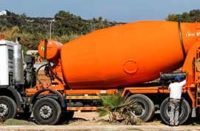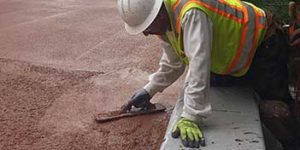How often in the course of your day do you think about breathing? Unless you’re one of those unfortunate people who suffers from a respiratory illness, it’s unlikely you give it any thought at all. The fact that breathing is a somewhat involuntary action is probably why we so easily take it for granted. It’s only when we have difficulty with it that we become concerned and by then it may be too late.
Workers in the concrete construction industry face numerous hazards on any given job site but respiratory hazards can be particularly dangerous. Whether it be airborne silica particulates from cutting or grinding concrete or chemical inhalation hazards in the form of mists, vapors, fumes, dusts or exhausts, precautions must be taken to ensure the safety and health of all employees.
We often pay more attention to those hazards that immediately affect our safety or health and less attention to other hazards that, while still very dangerous, manifest as a chronic or long-term danger.
Frequently, workers themselves don’t recognize the need for proper respiratory protection. Younger workers feel healthy and invincible and older workers often say, “I’ve been doing this for years and I’m fine” — right up until the time they lose a portion of their lung function or are diagnosed with a life-threatening illness. This is why proper training and supervision are needed at all levels on a job site. Respiratory protection for construction workers can be at times inadequate and, worse yet, nonexistent.
Legal requirements
Section 5(a)(1) of the federal Occupational Safety and Health Act states: “Each employer shall furnish to each of his employees employment and a place of employment which is free from recognized hazards that are causing or are likely to cause death or serious physical harm to his employees.”
The respiratory protection standard for the construction industry is found in General Industry Standard 29 CFR 1910.134 (a) (1). This OSHA standard spells out the construction employers’ responsibilities regarding respiratory protection for their employees.
Providing a safe and healthful job site is not only a legal requirement but has ancillary benefits as well. Lost-time injuries are reduced, labor and industry insurance rates are lower, the cost of training replacement workers goes down, and morale and productivity can go up.
Any successful health and safety program must have the key element of a solid commitment from top leadership. They must always lead by example and cannot tolerate safety becoming a second- or third-tier priority when production schedules become tight or some other distraction comes into play.
Safety controls
The higher hierarchy of safety controls should always be used when making any decisions regarding worker safety and is especially important regarding respiratory protection.
The hierarchies of safety controls are ordered as progressive methods used to protect workers. The steps are elimination, substitution, engineering controls, administrative controls and personal protective equipment (PPE). The chart on the next page offers a good graphic representation of the controls in order of effectiveness.
Too often PPE is used as a default “solution” to a respiratory hazard. A worker may be handed a dust mask or some type of respirator and be expected to complete a task when, with a proper job hazard analysis and the implementation of the hierarchy of safety controls, the level of PPE may be lowered or eliminated altogether.
If there’s another way to protect workers’ lungs other than with a PPE, that method should be used. However, some work may require using a respirator. When it is, employers are required to provide the proper respirator, training and fit-testing to ensure the PPE is effective.
SDS availability is critical
A Safety Data Sheet (SDS), formerly known as a Material Safety Data Sheet (MSDS), has a wealth of information regarding hazards associated with products and chemicals found in construction. They are supplied by the manufacturer and can be accessed in either a paper or digital format.
The Hazard Communication Standard – 29 CFR 1910.1200 requires employers to make an SDS available to employees on the job site and the employer is required to provide training in the use and understanding of an SDS. These sheets contain important information needed to determine what safety protocols to use.
An SDS should always be referenced anytime a new product is introduced or when a new employee will be using the product. The SDS provides important information including inhalation hazards, vapor density, vapor pressure, and physical and health hazards. Reading and understanding the SDS is critical when planning for respiratory protection.
The power of HEPA
Technology has made great strides regarding dust mitigation in construction. High Efficient Particulate Air (HEPA) filters on saws, grinders, chipping guns, polishers and vacuums have significantly reduced worker exposures to concrete and silica particulates.
In fact, hundreds of products today let contractors control dust and other particulates on a job site. Virtually every dust-generating power tool used in concrete construction can now be purchased with a powered collection system and HEPA filters in place.
These tools not only protect workers who perform the work, but they also protect those working nearby from hazardous dust exposure. Workers’ family members also benefit by not being exposed to these hazardous substances that would otherwise be brought home on workers’ clothing.
Cleanup time and expense are also reduced by capturing the dust at the generation source. Most suppliers of HEPA-equipped tools and equipment provide free training in the proper use and maintenance of their products.
Helpful websites
CPWR, The Center for Construction Research and Training, has an excellent website, Work Safely With Silica. This site has online tools for developing a safe work plan when working with respirable silica dust. The site and all its resources are available to the public. An employer can develop a safe work plan online, save it, use it and modify it for the next job.
With good job hazard analysis, proper planning and quality training for both supervisors and workers, everyone can return to their families healthy and safe every day.
There are many good websites online dealing with respiratory protection in the construction industry. Two I recommend are “OSHA’s Final Rule to Protect Workers from Exposure to Respirable Crystalline Silica” [https://www.osha.gov/silica/index.html] and “Respiratory Protection in Construction: An Overview of Hazards & OSHA’S Program Requirements” [https://www.osha.gov/video/respiratory_protection/construction_transcript.html].

















